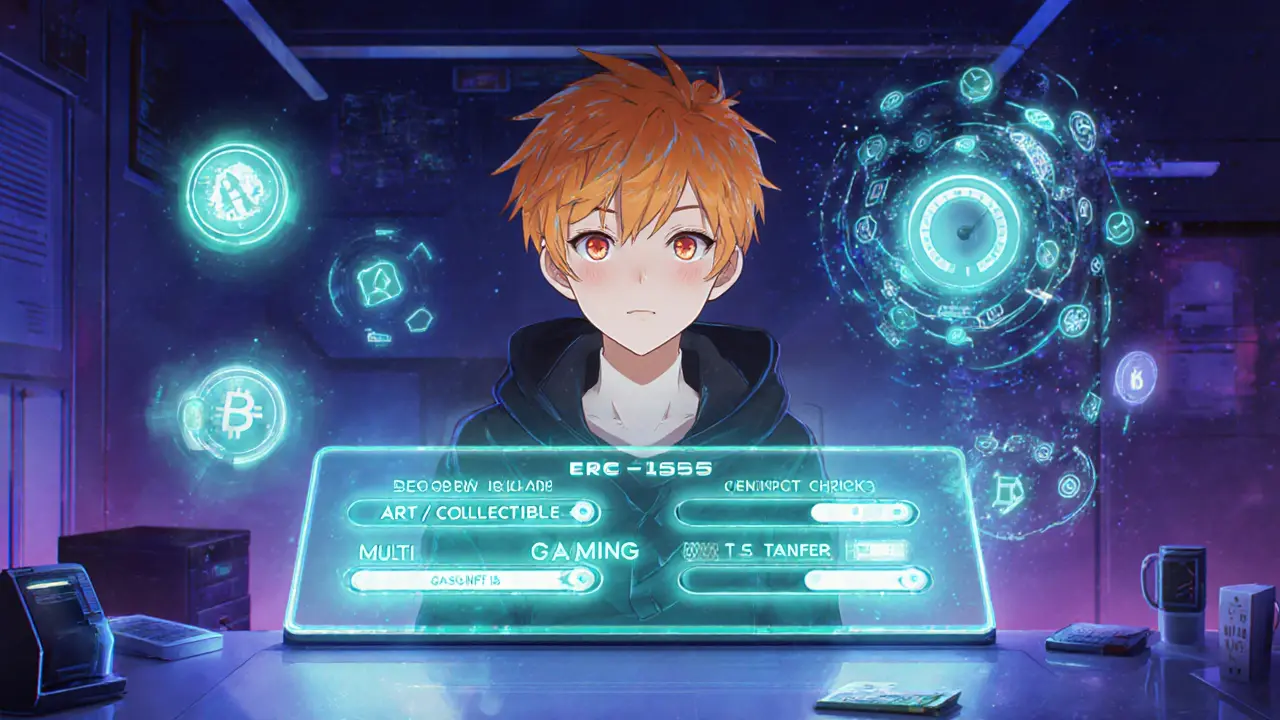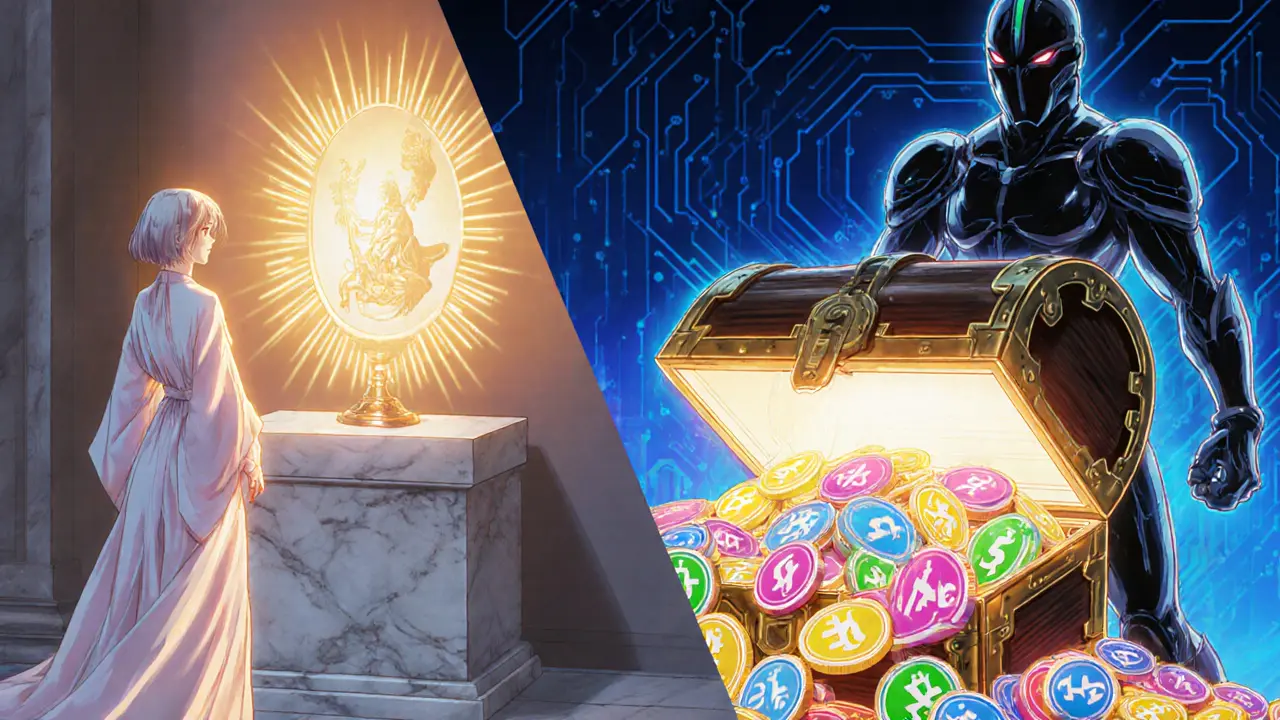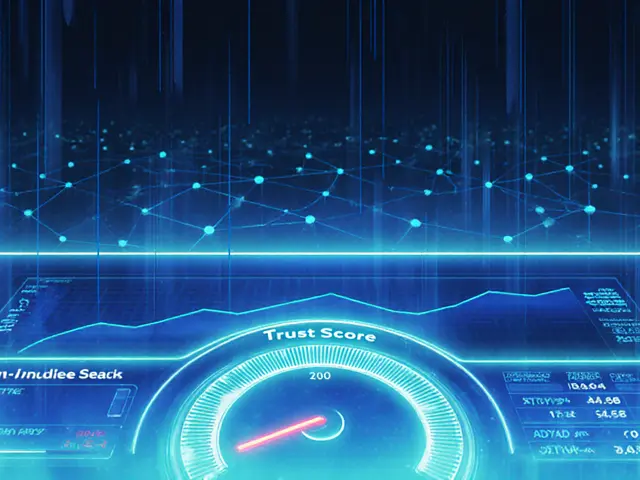ERC-721 vs ERC-1155 Comparison Tool
Original NFT standard for unique, indivisible tokens. Best for art, collectibles, and single-item collections.
- ✓ Pure NFTs
- ✓ Simple to implement
- ✓ Mature ecosystem
- ✗ No batch transfers
Multi-token standard supporting fungible, semi-fungible, and non-fungible assets in one contract.
- ✓ Multi-token support
- ✓ Batch transfers
- ✓ Gas efficient
- ✓ Built-in security
| Feature | ERC-721 | ERC-1155 |
|---|---|---|
| Token types supported | Non-fungible only | Fungible, semi-fungible, non-fungible |
| Deployment model | One contract per collection | Single contract hosts multiple collections |
| Gas cost per transfer | ~45,000 gas (single NFT) | ~5,000 gas per token in batch (up to 90% saving) |
| Batch transfers | No native support | Built-in safeBatchTransferFrom |
| Metadata handling | URI per token ID | URI per token type |
| Security extras | Standard ownership checks | Verification callbacks, safe recovery |
Recommended Standard
Choosing the right token standard can make or break an NFT project. ERC-721 is the original non‑fungible token (NFT) model, while ERC-1155 offers a multi‑token approach that handles fungible, semi‑fungible and non‑fungible assets under one contract. Below you’ll see a side‑by‑side rundown, real‑world use cases, and a quick decision guide that lets you pick the standard that matches your goals.
Quick Take
- ERC‑721: pure NFT, simple to code, best for art & collectibles.
- ERC‑1155: multi‑token, batch‑transfer friendly, saves up to 90% gas on large moves.
- Pick ERC‑721 for single‑type collections; choose ERC‑1155 when you need currencies, items, or layered assets together.
What Exactly Are ERC‑721 and ERC‑1155?
ERC-721 is a standard that defines a unique, indivisible token on the Ethereum blockchain. Each token ID maps to its own metadata, so ownership is always one‑to‑one.
ERC-1155 is a flexible standard that lets a single contract manage multiple token types - fungible, semi‑fungible, and non‑fungible - simultaneously. It was created by Enjin to cut down on contract bloat and transaction fees.
Ethereum provides the execution environment where both standards live, using smart contracts written in Solidity.
Core Technical Differences
Below is a distilled view of the architectural gaps.
| Feature | ERC‑721 | ERC‑1155 |
|---|---|---|
| Token types supported | Only non‑fungible | Fungible, semi‑fungible, non‑fungible |
| Deployment model | One contract per collection | Single contract can host unlimited collections |
| Gas cost per transfer | ~45,000gas (single NFT) | ~5,000gas per token in batch (up to 90% saving) |
| Batch transfers | No native support - requires multiple calls | Built‑in safeBatchTransferFrom |
| Metadata handling | URI per token ID, stored on‑chain or IPFS | URI per token type, supports multiple URIs via an array |
| Security extras | Standard ownership checks | Verification callbacks, safe recovery if sent to wrong address |
| Ideal use cases | Art, PFPs, single‑item collectibles | Gaming, metaverse, marketplaces needing currencies & items together |
Gas Efficiency in Real Numbers
Gas fees dominate the cost equation for NFT launches. Because ERC‑1155 can bundle up to 100 tokens in one transaction, developers report up to a 90% reduction in total gas spent. A recent Chetu analysis showed minting 10,000 items cost ~0.45ETH with ERC‑721 versus ~0.07ETH with ERC‑1155 on the same network conditions.
ERC‑721A, the gas‑optimized variant of ERC‑721, narrows the gap (50‑80% lower gas for batch minting) but still lags behind the native batch architecture of ERC‑1155.

Security & Transaction Reliability
ERC‑1155 adds a ERC1155Receiver interface that forces the recipient contract to explicitly accept the tokens. This prevents accidental loss when sending to a contract that can’t handle NFTs. It also includes a safeBatchTransferFrom method that reverts the whole batch if any single token fails, reducing partial‑state errors.
ERC‑721 lacks these batch safety nets, so developers often code extra checks or rely on external tools to avoid “tokens sent to the wrong address” mishaps.
Implementation Complexity - What Developers Face
For a junior dev, ERC‑721 reads like a straightforward tutorial: one mint function, a mapping from token ID to owner, and few OpenZeppelin contracts to import. Typical learning curves sit at 2‑3weeks.
ERC‑1155, by contrast, introduces token type IDs, balance matrices (mapping(uint256 => mapping(address => uint256))), and batch logic. Expect 4‑6weeks of ramp‑up, especially if you need to handle both fungible and non‑fungible assets.
That said, the payoff is huge for projects that need a mix of assets. Gaming studios often cite ERC‑1155 as the only viable path to ship in‑game currencies, weapons, skins, and loot boxes without spawning dozens of separate contracts.
Adoption Landscape - Who Uses What?
Art‑focused collections like Bored Ape Yacht Club, CryptoPunks, and most PFP projects still run on ERC‑721, leveraging its simplicity and marketplace compatibility (OpenSea, Rarible).
GameFi and metaverse platforms - Enjin, Immutable X, Gala Games - have embraced ERC‑1155 for its multi‑asset support. In 2024 the NFT gaming sector hit $4.6billion in trading volume, with ERC‑1155 powering the majority of those transactions.
Enterprises that need tokenized vouchers, loyalty points, or supply‑chain certificates also lean toward ERC‑1155 because a single contract can represent dozens of token types, cutting down on audit overhead.
Decision Guide - Which Standard Wins for Your Project?
- Is your product a pure art or collectible series? Go with ERC‑721. Its ecosystem is mature, and most marketplaces expect it.
- Do you need both currency‑like tokens and unique items? ERC‑1155 lets you mint a gold coin (fungible) and a legendary sword (non‑fungible) in the same contract.
- Are you building on a layer‑2 or sidechain? Both standards work, but ERC‑1155’s batch savings become even more pronounced where transaction fees are already low.
- Do you have a small dev team or tight deadline? ERC‑721’s lower learning curve may win.
- Do you need native DEX integration? ERC‑1155 includes built‑in hooks that many decentralized exchanges already support.
If you still can’t decide, prototype a minimal ERC‑721 collection, then expand to ERC‑1155 as your token ecosystem grows.
Future Outlook
Both standards will coexist for years. ERC‑721A continues to shrink gas gaps, while ERC‑1155 road‑maps focus on cross‑chain bridges and tighter security audits. As Layer‑2 scaling solutions mature, the relative cost advantage of ERC‑1155 may shrink, but its functional breadth will keep it the go‑to choice for complex token economies.

Frequently Asked Questions
Can I use ERC‑721 and ERC‑1155 in the same project?
Yes. Many platforms run both standards side‑by‑side - ERC‑721 for pure art collections and ERC‑1155 for in‑game items. Just deploy two contracts and reference them in your front‑end.
Which standard is more secure?
Security depends on implementation, but ERC‑1155 includes built‑in verification callbacks that reduce accidental loss. ERC‑721 can be equally secure with proper checks, but it lacks those native safeguards.
Do marketplaces like OpenSea support ERC‑1155?
OpenSea added full ERC‑1155 support in 2020. You can list both fungible and non‑fungible items, though the UI treats them slightly differently from ERC‑721.
How does batch minting work in ERC‑1155?
The mintBatch function accepts an array of token IDs and an array of amounts. All tokens are written in a single transaction, which dramatically cuts gas and ensures atomicity.
Is ERC‑721A a replacement for ERC‑1155?
No. ERC‑721A is an optimization of ERC‑721 that reduces gas for batch minting, but it still only handles pure NFTs. ERC‑1155 remains the only standard that natively mixes token types.







Comments
Lindsay Miller
June 13, 2025 AT 05:13 AMBoth ERC‑721 and ERC‑1155 have their own strengths. If you need pure, one‑of‑a‑kind NFTs, ERC‑721 is straightforward. If you want to handle many token types in one contract, ERC‑1155 saves you gas and effort.
Katrinka Scribner
June 13, 2025 AT 05:31 AMI luv how 1155 saves gas 😍💰
Waynne Kilian
June 13, 2025 AT 05:50 AMThinking about the bigger picture, it’s nice to see standards that encourage collaboration across projects. ERC‑1155’s flexibility can bridge art and gaming, while ERC‑721 still shines for pure collectibles. Open‑minded developers can even mix both for a richer ecosystem.
Naomi Snelling
June 13, 2025 AT 06:08 AMEveryone talks about gas savings, but have they mentioned the hidden centralization risk? Some folks say batch transfers are safe, yet the contracts get way too complex, making it easy for a backdoor to slip in unnoticed.
april harper
June 13, 2025 AT 06:26 AMOh, the tragedy of choosing between elegance and efficiency! One feels the weight of tradition with ERC‑721, the other the promise of innovation with ERC‑1155. Yet the soul of the project must decide.
Clint Barnett
June 13, 2025 AT 06:45 AMLet’s dive deep into the colorful tapestry that is the NFT standards landscape, shall we?
ERC‑721, the granddaddy of unique tokens, offers a crystalline simplicity that appeals to artists craving a one‑to‑one relationship between token and masterpiece.
Its lineage is pure, its ecosystem mature, and marketplaces have wrapped it in a comforting blanket of compatibility.
However, this purity comes at a price-each transfer can gnaw at your wallet with roughly forty‑five thousand gas, and the lack of native batch operations forces developers to write repetitive, error‑prone code.
Enter ERC‑1155, the flamboyant chameleon that can juggle fungible, semi‑fungible, and non‑fungible assets under a single roof.
Its batch transfer mechanism is a masterstroke, slashing per‑token gas costs down to a few thousand when you move a hundred items at once-an almost ninety percent saving that can turn a costly launch into a budget‑friendly triumph.
Beyond economics, ERC‑1155 introduces safety nets: the ERC1155Receiver interface obliges recipient contracts to explicitly accept tokens, dramatically reducing the risk of accidental loss.
The safeBatchTransferFrom function further ensures atomicity, reverting the entire batch if any single token trips a snag, a safeguard ERC‑721 simply lacks out of the box.
From a developer’s perspective, the learning curve is steeper. You must grapple with a balance matrix, token type IDs, and more intricate minting functions, which can add four to six weeks of onboarding time for a junior team.
But for gaming studios, metaverse architects, or any project that needs currencies, weapons, skins, and loot boxes coexisting, this initial investment pays off handsomely.
Real‑world adoption backs these claims: while iconic art collections like Bored Ape Yacht Club still cling to ERC‑721, giants of GameFi such as Enjin and Immutable X have embraced ERC‑1155 to power billions in in‑game transaction volume.
Moreover, enterprises leveraging tokenized vouchers or loyalty points find ERC‑1155’s single‑contract multi‑token model curtails audit overhead and streamlines governance.
In short, if your vision is a pure art showcase, ERC‑721 is the reliable canvas; if you’re building a vibrant, multi‑asset economy, ERC‑1155 is the versatile palette that lets you paint with both gold coins and legendary swords without spawning a legion of contracts.
Choose wisely, balance your team’s expertise, and remember that both standards will likely coexist, each serving its niche in the ever‑evolving blockchain cosmos.
Jacob Anderson
June 13, 2025 AT 07:03 AMSure, because batch transfers are the end of the world and we all need to reinvent the wheel every time.
Kate Nicholls
June 13, 2025 AT 07:21 AMWhile the previous comment leans into sarcasm, the practical takeaway remains: ERC‑1155’s batch feature genuinely reduces friction for large‑scale projects. That said, the simplicity of ERC‑721 can still be advantageous for smaller art drops.
Carl Robertson
June 13, 2025 AT 07:40 AMOh, the drama of debating standards! One minute we’re praising gas savings, the next we’re lamenting developer headaches. It’s almost theatrical, but the reality is that each choice writes a different story for your users.
Rajini N
June 13, 2025 AT 07:58 AMBottom line: assess your project’s token diversity, team expertise, and roadmap timeline. If you’re launching a simple art collection, go ERC‑721. If you need a mix of currencies, items, and collectibles, ERC‑1155 will save you gas and simplify contract management.